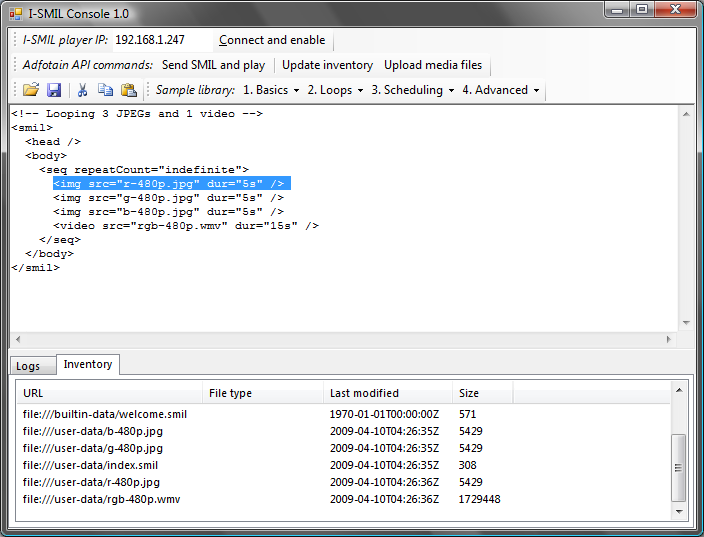Difference between revisions of "Main Page"
m (Added 2nd-level links) |
(Added "What) |
||
| Line 1: | Line 1: | ||
| + | [[File:Screenshot-Hornet_1.0.png|thumb|'''What's New''': Download full source code for [[Hornet 1.0]], a Windows-based management software for SMIL media players.]] | ||
| + | |||
This website advocates using SMIL as an open standard for [[Wikipedia:digital signage|digital signage]]. | This website advocates using SMIL as an open standard for [[Wikipedia:digital signage|digital signage]]. | ||
| Line 4: | Line 6: | ||
SMIL (pronounced "smile") stands for "Synchronized Multimedia Integration Language" and defines scheduling ("synchronized"), video, audio, images, text ("multimedia"), multi-zone screen layout ("integration") in an XML-based text file format ("language"). It is an open specification (royalty-free to use) created by the World-Wide Web Consortium, the same organization responsible for defining the HTML language, an open standard for the Internet. Products that utilize SMIL are available from leading companies such as Adobe, Apple, Microsoft, and Real Networks. | SMIL (pronounced "smile") stands for "Synchronized Multimedia Integration Language" and defines scheduling ("synchronized"), video, audio, images, text ("multimedia"), multi-zone screen layout ("integration") in an XML-based text file format ("language"). It is an open specification (royalty-free to use) created by the World-Wide Web Consortium, the same organization responsible for defining the HTML language, an open standard for the Internet. Products that utilize SMIL are available from leading companies such as Adobe, Apple, Microsoft, and Real Networks. | ||
| − | |||
| − | |||
Digital signage deals with scheduling multimedia files for playback on digital displays connected on an IP network. The industry has roots tracing back for a few decades, but has recently expanded rapidly due to the proliferation of low-cost flat panel displays that are easy to install and maintain in public space. As the market expands out of the "emerging" status, mainstream customers demand compatibility and interoperability among products from different vendors. SMIL appears to be an ideal technology to answer the needs of the industry. | Digital signage deals with scheduling multimedia files for playback on digital displays connected on an IP network. The industry has roots tracing back for a few decades, but has recently expanded rapidly due to the proliferation of low-cost flat panel displays that are easy to install and maintain in public space. As the market expands out of the "emerging" status, mainstream customers demand compatibility and interoperability among products from different vendors. SMIL appears to be an ideal technology to answer the needs of the industry. | ||
| − | A SMIL playlist that plays 2 videos repeatedly looks | + | A SMIL playlist that plays 2 videos repeatedly looks as simple as this: |
<source lang="smil"> | <source lang="smil"> | ||
Revision as of 07:07, 10 April 2009

This website advocates using SMIL as an open standard for digital signage.
SMIL as an Open Standard for Digital Signage
SMIL (pronounced "smile") stands for "Synchronized Multimedia Integration Language" and defines scheduling ("synchronized"), video, audio, images, text ("multimedia"), multi-zone screen layout ("integration") in an XML-based text file format ("language"). It is an open specification (royalty-free to use) created by the World-Wide Web Consortium, the same organization responsible for defining the HTML language, an open standard for the Internet. Products that utilize SMIL are available from leading companies such as Adobe, Apple, Microsoft, and Real Networks.
Digital signage deals with scheduling multimedia files for playback on digital displays connected on an IP network. The industry has roots tracing back for a few decades, but has recently expanded rapidly due to the proliferation of low-cost flat panel displays that are easy to install and maintain in public space. As the market expands out of the "emerging" status, mainstream customers demand compatibility and interoperability among products from different vendors. SMIL appears to be an ideal technology to answer the needs of the industry.
A SMIL playlist that plays 2 videos repeatedly looks as simple as this:
<seq repeatCount="indefinite"> <video src="ad1_15s.mpg" /> <video src="ad2_30s.mpg" /> </seq>
Further Reading
- SMIL Tutorial
- SMIL Media Objects: video, image, smilText, and audio objects
- SMIL Playlists: seq, par, and excl playlists
- SMIL Screen Layout: multi-zone, multi-layer layout
- Sending SMIL to Player: network management protocol for media players
- SMIL Reference